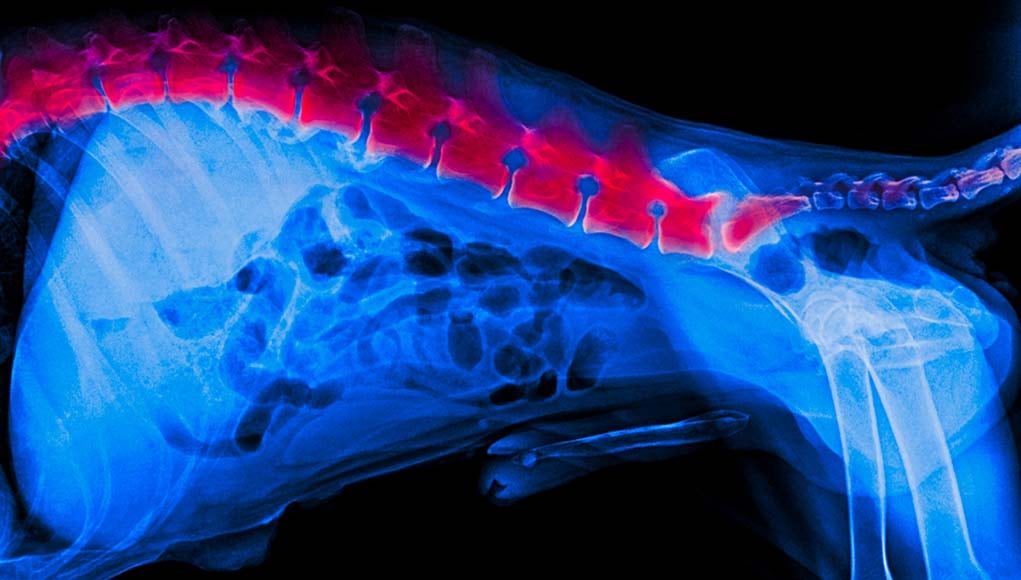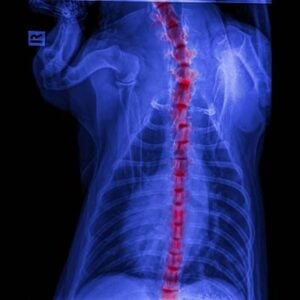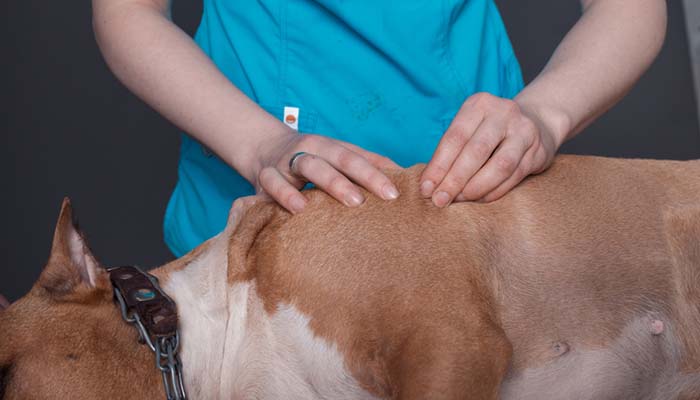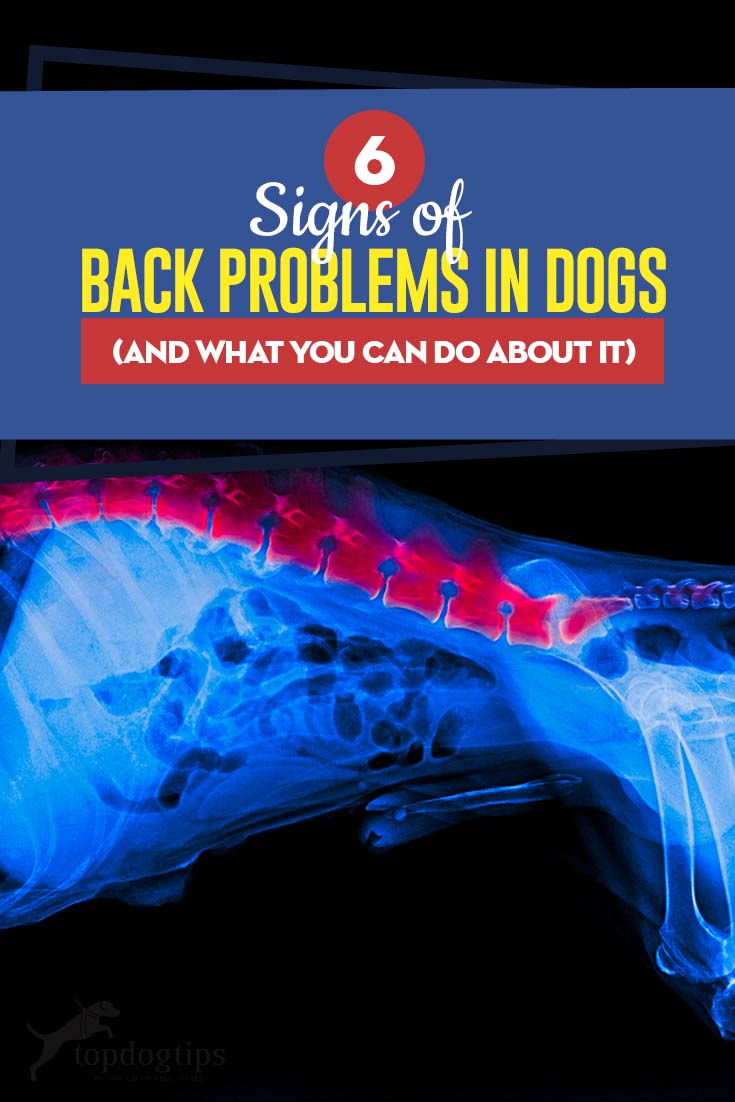Dogs may not sit in front of the computer for hours the way some of us do, but that doesn’t make them immune to back problems. Some of the back problems in dogs can simply be inconvenient while others can be downright incapacitating. Recognizing signs early can save your pup from a lot of pain.
Signs of Back Problems in Dogs
Recognizing back problems your pooch might have is not always easy since the signs can often be very subtle. However, you will probably be able to tell that something is wrong with your pupper if you pay close attention to details.
1. Changes in Posture
Compared to your pet's typical stance, you'll notice that the dog now stands awkwardly when he has pain in his back. He might arch the back or seem hunched over. A dog with back problems might also stretch frequently in an attempt to relieve the pressure on his spine.
You might spot changes in your pup's posture when he walks as well. If he has a wobbly or unusual gait, it may be a sign of a back-related issue.
2. Vocalization of Pain
If your Fido starts to whimper, yelp, or cry when he moves or when you touch his back, he might have a problem with his back. However, some dogs are completely silent despite the pain, so don’t take the lack of vocalization as a sign that your dog is fine when you observe other signs. If there are any other potential symptoms present, those may still indicate back problems.
3. Bladder Control
Some dogs have problems when they urinate if something is wrong with their backs. This includes difficulty urinating, inappropriate elimination, or even incontinence on a regular basis. Back problems can also cause the pet pain during defecation.
4. Stiffness and Weakness
 Stiffness usually accompanies back problems. Your dog may become reluctant to turn his head and he might simply move his entire body instead. He may also show an inability or reluctance to walk or stand up. His movement may become limited and he will start to move more slowly.
Stiffness usually accompanies back problems. Your dog may become reluctant to turn his head and he might simply move his entire body instead. He may also show an inability or reluctance to walk or stand up. His movement may become limited and he will start to move more slowly.
If the injury is causing pain to your dog, his back legs may become weakened and he may try to avoid using them.
5. Bruising or Bleeding
Visible bruises on your dog’s back are a clear sign of an injury. Other noticeable physical symptoms include bleeding, lacerations, and puncture wounds. And even if there is no bruising, you may notice abnormal alignment or curvature of the animal's spine, which often indicates some back issue.
6. Behavioral Changes
If you sense that your dog’s behavior has changed in any way, it usually means that something is wrong. Your pooch might pace more, refuse to do his normal activities, or lose his appetite. Behavioral changes can be caused by many different health issues, including back pain or discomfort.
RELATED: 8 Ways to Prevent Injuries in Dogs
What Causes Dog Back Problems?
While any dog can experience back problems, some breeds are more likely to suffer from certain conditions. For example, Pekingese, Dachshunds, Beagles, Corgis, Poodles, and Shih Tzus are prone to chronic back problems. German Shepherds and Boxers are at higher risk of spondylosis.
Age can also be a huge factor in developing back problems, as well as obesity. Some back issues are a result of overexertion, especially muscle spasms. Trauma and injuries to the back will almost always result in back pain, at least for the short term.
Common medical conditions that cause back pain in dogs include arthritis, spondylosis, degenerative myelopathy, slipped disc, enlarged prostate, and disorders of the meninges (membranes that cover the dog's spine and brain). Cancer on the spine or vertebrae can also cause back issues, although it is not that common.
Veterinary Treatments for Back Problems
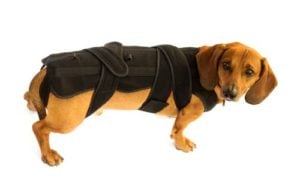
Treatment for back problems in dogs will depend on the specific issue, so take your pooch to a vet clinic to get the correct diagnosis first.
For example, treating intervertebral disc disease entails physical therapy, anti-inflammatory medications, and rest. The vet may also prescribe a special veterinary orthopedic bandage for the dog's back like the one you can see in the photo to the right. In some more severe cases, back surgery is another (necessary) option.
Muscle spasms require rest but your vet may also prescribe muscle relaxants to decrease the tension in the muscles around your dog’s spine. Hydrotherapy may be also recommended for relief from back pain.
Back problems caused by an enlarged prostate can be prevented by neutering/spaying. If your dog develops prostate problems, your vet may prescribe a series of antibiotics along with some anti-inflammatory drugs.
Cancer treatment includes surgery, radiation therapy, and chemotherapy.
What You Can Do for Your Dog's Back Issues
In addition to medical treatment, there are some things you yourself can do at home to prevent back issues in the first place, but also help your dog with his back problems and make his life more comfortable and less painful.
1. Watch Your Dog’s Weight
Maintaining healthy weight is key to preventing and dealing with back issues. Monitor your dog’s weight to make sure that he is not overweight or obese. Excess weight will strain your dog’s back and may cause additional problems. If your dog needs to lose weight, ask your vet to recommend a weight loss plan.
2. Monitor Exercise
Exercise is a good way to prevent issues with the back as it keeps your dog's muscles strong and stretched. While exercise is also important for dogs that already have back problems, you will probably need to limit the extent of it to avoid potential irritation to the back. Stick to light walks and avoid running, jumping or any other activity that involves sharp motions which may hurt the pet's back.
3. Install Ramps or Use Steps
 If your dog has back problems, using ramps or stairs to help the dog get onto beds, into cars, and so on is a good way to help him limit straining. You may have to take some time to train your pooch to use pet ramps or pet steps but it will definitely make his life easier.
If your dog has back problems, using ramps or stairs to help the dog get onto beds, into cars, and so on is a good way to help him limit straining. You may have to take some time to train your pooch to use pet ramps or pet steps but it will definitely make his life easier.
For dogs with severe back issues, ramps are better than steps; installing ramps on the stairs is also particularly important, especially if your dog uses them often.
4. Avoid Slippery Surfaces
Dogs with back problems often have difficulty walking, particularly on slippery surfaces. If your home has tiles, hardwood floors, or linoleum, consider covering them with carpets or mats to ensure your dog’s comfort and safety. If your pooch has chronic back problems that are likely to stay for the rest of his life, you may need to install special flooring that's more favorable for your pup.
5. Get a Special Harness
A special, high-quality dog harness can help your Fido do his daily activities a lot easier if he has back problems. Some of the special sling harnesses out there are specifically made for walking support for dogs with arthritis, as well as back, hip, and joint problems.
For example, this harness allows you to pick up your pup's hindquarters without bending down and provide your pooch with extra support when he walks. To save money, you can also make your own DIY rear leg sling which will work just as well.
6. Try Alternative Medicine
In addition to the traditional modern medication that will be prescribed by your vet, you can also ask them to recommend some alternative therapy and natural remedies to help alleviate the dog’s back pain. You can try physical therapy, hydrotherapy, laser therapy, acupuncture, massages, or even localized hot and cold therapy.
When it comes to natural remedies for back problems in dogs, Chinese herbal medicine is believed to have very positive effects based on anecdotal evidence (there are no studies to prove its effectiveness, however). You can also try antioxidants or dietary supplements with glucosamine and chondroitin, most commonly the same supplements used for arthritis. However, you should always consult your veterinarian before you add any supplements or natural remedies to your dog’s diet.
In Summary
Back problems in dogs are a relatively common occurrence, especially in senior dogs. They can be either genetic or come as a result of an injury or some specific health issue. If your pooch has back problems, take him to the veterinarian to get the right diagnosis and a therapy plan.
While you cannot treat dog back problems yourself, you can help the dog with pain and discomfort as well as manage those back issues in a few ways, such as watching the pet's weight, ensuring proper exercise regime, covering slippery surfaces with carpets and installing ramps or using sling harnesses.
READ NEXT: 8 Signs Your Dog Is Experiencing Joint Pain


